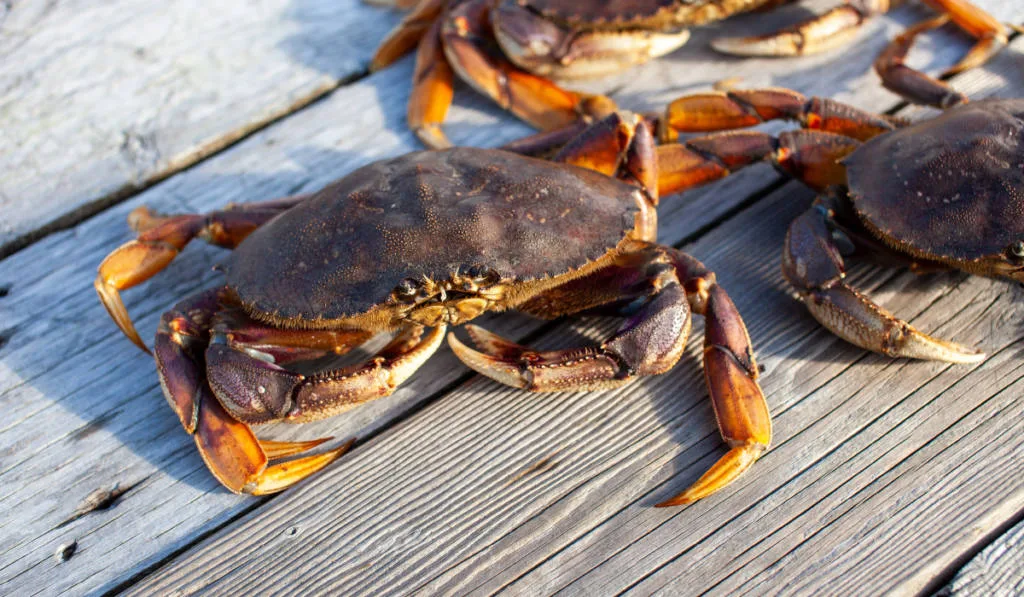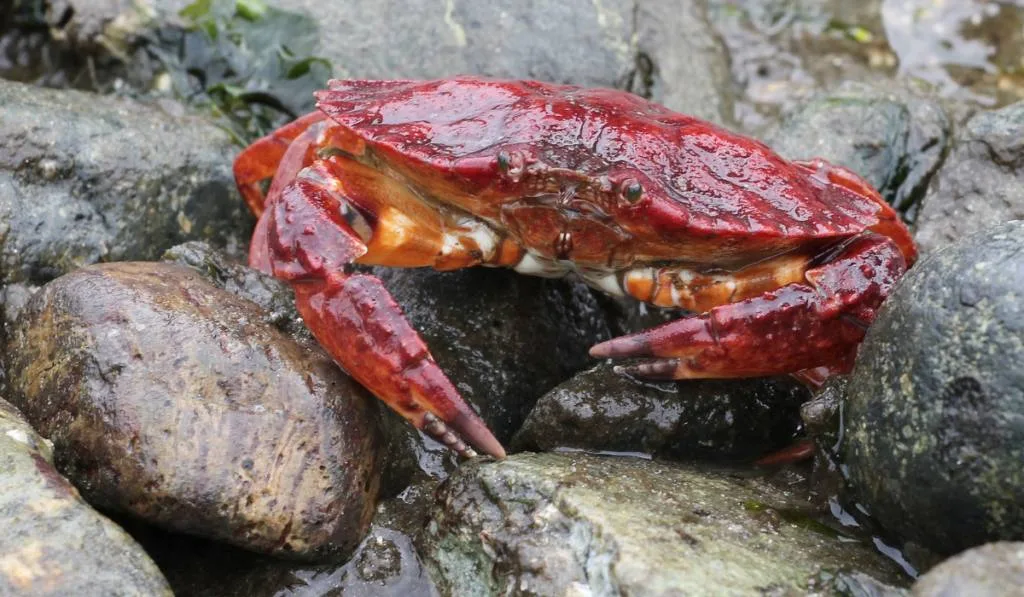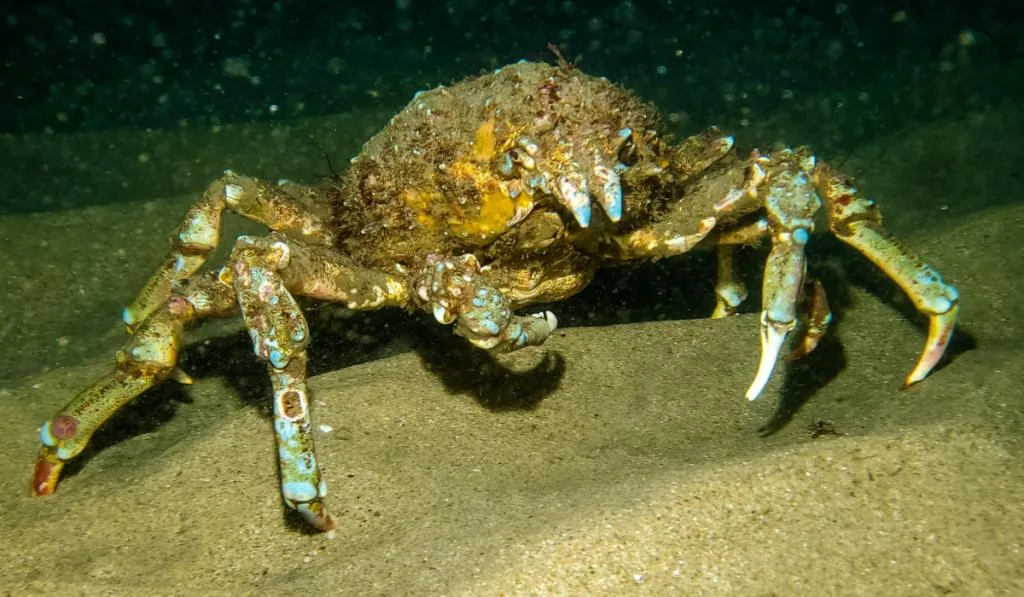Have you ever been to California or dreamed about visiting? So many people wish they could visit or are happy that they have, especially the coastal areas. The sceneries are truly incredible while nature is amazingly beautiful.
California also has a pleasant Mediterranean climate with warm, dry summers and wet, cooler winters. These conditions helped with developing rich flora and fauna which includes plenty of invertebrates (species with no bony skeleton).
Among these are crabs, and you might be surprised by how many different types of crabs call California home.
Table of Contents
Dungeness Crab (Metacarcinus Magister)

Dungeness crabs are the most plentiful crab type in California. They prevalently inhabit the area north of Monterey Bay.
These invertebrates can reach a size of 10 inches or even more, and their average lifespan is 8-13 years. They have 4 pairs of legs together with a bit wider, quite long rocklike outer shell called a carapace.
Natural habitats for adult crabs are muddy and sandy bottom areas, while juveniles usually live in more shallow estuarine parts where they can hide within protective structures like woody debris and pilings.
Generally speaking, they avoid going to the habitat where adult crabs are.
Dungeness crab’s meat is mild, tender, and sweet, and you will find the most of it in its claws.
Yellow Crab (Cancer Anthonyi)

Yellow crabs can usually be found in the area between Bahia Magdelena and Humboldt Bay in Northern California.
They mostly live on sandy habitats 60-180 feet under the sea, but their presence is recorded from incredible depths that go down to 430 feet.
You can identify them for their oval, hard, and rather broad outer shell. Another one of their recognizable features is pretty noticeable black-tipped pincers on their strong and large claws.
Their color is often something between yellow and yellowish-brown, noting there is a bit of purple wash from the front side of their body. Along with that, adult yellow crabs are a little lighter than juveniles.
Their taste is excellent, and the most delicate meat can be found in the claws.
Red Crab (Cancer Productus)

This type has a big, wide, and tough carapace coupled with black-tipped pincers on their rough, strong claws.
Unlike with Dungeness crabs, their claws are not saw-toothed. Another one of the features that distinguishes them from other crabs is their big, broad tail flaps.
As their name indicates, their main color is red. Adults are typically brick red on top and a bit yellow underneath while the young ones show various color patterns such as spots, stripes, or white parts.
Male red crabs can grow up to 7-8 inches across the back while females are usually 6 inches.
Even though the presence of red crabs has been noted at depths of 300 feet, they mainly live in shallow and rocky inshore areas such as boulder-strewn beaches and rugged reefs.
They cannot survive on muddy bottoms or beaches with pure sand. Red crabs also do not tolerate a low level of salinity.
When it comes to food, Red crabs are carnivorous and will consume smaller crabs, barnacles, dead fish, and almost anything that comes their way.
However, green crabs are one of their favorites, and this is actually a good thing. Green crabs are considered to be quite invasive and can destroy seagrass while hunting for scallops and clams. Red crabs snacking on green crabs helps the ecosystem and maintains biodiversity.
Red crabs provide less flesh than Dungeness crabs, so they are not widespread on the commercial market for human consumption. Still, the meat has a quite delicate and sweet flavor.
Brown Crab or Rock Crab (Cancer Antennarium)

Brown crabs, or as they are sometimes called rock crabs, also have wide shells and big, smooth pincers with black tips.
Their legs are rather hairy in appearance. They are also notable for their antennae placed between eyestalks, the longest of the similar types of crabs.
Both males and females have the tip of their tail flap pointed. Their color typically goes from orange and medium to dark red-brown to some lighter gray shade. Their undersides are something between yellow and white with tiny red spots.
A brown crab’s hard shell can grow up to 6 inches across. They have four pairs of relatively short legs, while the fifth pair is quite small and folded under the shell, hidden so that you cannot see it.
Brown crabs can be found in different parts of California such as the area between Cabo San Lucas, Baja California to Queen Charlotte Islands, British Columbia. The range where most Brown crabs live stretches from Mexico to San Francisco Bay.
Their natural habitat is shallow inshore surroundings mostly mud, sand, gravel, and rock substrata.
Brown crabs do not tolerate brackish conditions like some other crabs do. They eat snails, echinoderms, various bivalves, and some other crustaceans.
People tend to favor the delicate taste of brown crab over Dungeness crabs.
Sheep Crab (Loxorhynchus Grandis)

Sheep crabs are also known as spider crabs. Their oval-shaped body is covered in bumps and spines. It is also recognizable for long, crawling legs and large knobby joints.
Males can grow up to 6.5 inches, while female go up to 4.5 inches.
Sheep crabs live for at least four years, and you can mostly find them in the area of the Santa Barbara Channel and off the northern Channel Islands. Most of them are marketed in San Pedro and the wider area of Los Angeles County.
Traps to catch them are mainly set in shallow areas with sandy bottoms down to 30-70 feet in warmer seasons, while they are moved to depths down to 120-240 feet during the fall and winter.
Sheep crabs love to hide in pilings and reefs. Overfishing of sheep crabs can cause an imbalance in the regulation of algae and bottom-dwelling scavengers.
Sheep crabs are surprisingly delicious with a quite firm texture of meat in both legs and the body. However, they are not easy to clean or prepare.
Final Thoughts
California wildlife truly provides a wide variety of animal species, including the richness of the underwater world. The saltwater crabs we reviewed only scratch the surface of the diversity that you can find in California.
Resources
- https://wildlife.ca.gov/Fishing/Ocean/Dungeness-Crab.
- http://kenjonesfishing.com/2012/01/california-crabs
- https://noyocenter.org/dungeness-crab/
- https://www.pierfishing.com/red-crab-or-red-rock-crab/
- https://www.mariamitchell.org/get-involved/green-crabs
- https://caseagrant.ucsd.edu/seafood-profiles/brown-box-crab
- https://www.pierfishing.com/rock-crab-brown-rock-crab-or-pacific-rock-crab/
- https://wildlife.ca.gov/conservation/marine/invertebrates/crabs
- https://www.pierfishing.com/yellow-crab-or-yellow-rock-crab/
- https://caseagrant.ucsd.edu/seafood-profiles/rock-crab
- https://caseagrant.ucsd.edu/seafood-profiles/sheep-crab
- https://wildlife.ca.gov/Conservation/Invasives/Species/Mitten-Crab
